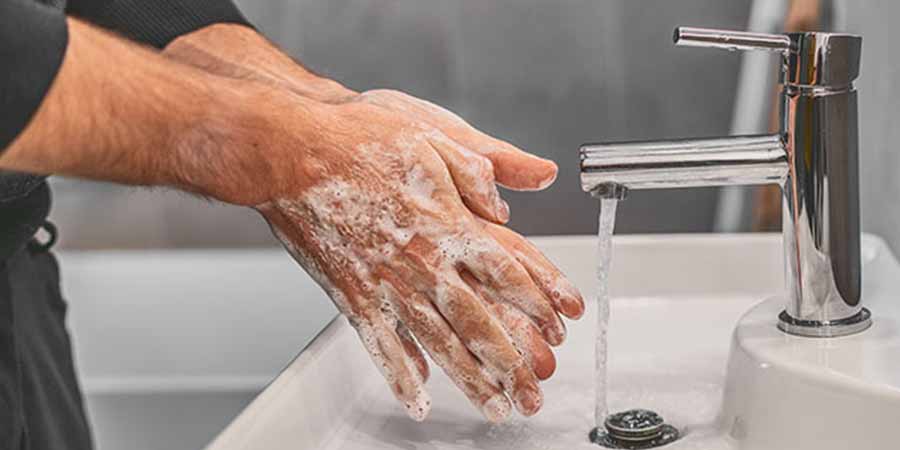
Good hand hygiene is one of the most important actions healthcare workers can take to reduce the spread of infection and protect the lives of their patients. Proper hand hygiene practices are a highly effective and inexpensive means of preventing healthcare-associated infections. According to the World Health Organization, such infections are the most frequent adverse events in healthcare, affecting hundreds of millions of patients globally and creating a tremendous economic burden on both developed and developing countries.
The term hand hygiene includes two primary actions: 1) washing the hands with soap and water to decrease colonization of transient flora by removing dirt, soil, and loose flora and 2) rubbing hands with a small amount of highly effective, fast-acting antiseptic agent, termed a hand sanitizer.
DISINFECTANT VERSUS ANTISEPTIC
Disinfectant: Usually a chemical agent (but sometimes a physical agent) that destroys disease-causing pathogens or other harmful microorganisms but might not kill bacterial spores. Refers to substances applied to inanimate objects. The Environmental Protection Agency (EPA) groups disinfectants by product label claims of “limited,” “general,” or “hospital” disinfection.
Antiseptic: Substance that prevents or arrests the growth or action of microorganisms by inhibiting their activity or by destroying them. The term is used especially for preparations applied topically to living tissue.
(Source: CDC, “Guideline for Disinfection and Sterilization in Healthcare Facilities.”)
ASEPTIC HAND CLEANSING
Hand Cleansing Technique
The following steps constitute the techniques outlined in the WHO guidelines for hand hygiene with soap and water. Caregivers are advised to follow the manufacturer’s recommendations about the product they are using.
Duration of the entire procedure: 40–60 seconds
- Wet hands with water.
- Apply the amount of soap product necessary to cover all hand surfaces.
- Rub hands palm to palm.
- Rub right palm over left dorsum with interlaced fingers, and vice versa.
- Rub palm to palm with fingers interlaced.
- Rub backs of fingers to opposing palms with fingers interlocked.
- Rub left thumb rotationally while clasped in right palm, and vice versa.
- Rub clasped fingers of right hand rotationally in left palm, backwards and forwards, and vice versa.
- Rinse hands with water. Avoid using hot water in order to decrease the risk of dermatitis.
- Dry hands thoroughly with a single-use towel.
- Use towel to turn off faucet.
The same technique is used when decontaminating hands with an alcohol-based hand rub, however no water is used. Similarly, towels are not used for drying, as hands will quickly dry on their own. When using alcohol-based hand rubs, the CDC recommends healthcare personnel rub their hands until the alcohol evaporates and the hands are dry.
Glove Use

Association of periOperative Registered Nurses (AORN) recommendations for the use of gloves in the clinical setting state:
- Wash hands before putting on or after removing gloves or any other personal protective equipment (PPE).
- Glove use does not replace the need for hand hygiene.
- Gloves are recommended in situations in which contact with blood or other potentially infectious material is likely.
- Remove gloves after caring for a patient and do not reuse.
- Change or remove gloves if moving from a contaminated body site to either another body site within the same patient or the environment.
- When gloves are removed, hands must be washed or an alcohol-based hand sanitizer used. (Patrick & Van Wicklin, “Implementing AORN Recommended Practices for Hand Hygiene.”)
The CDC further recommends that healthcare workers wear gloves in order to reduce the risk that:
- Caregivers will acquire infections from patients.
- Pathogens of caregivers will be transmitted to patients.
- Caregiver hands will transmit pathogens from one patient to another.
When there is a risk that hands may become heavily contaminated, caregivers should wear clean gloves as compared to sterile gloves. This is recommended because hand-cleansing asepsis does not remove all organisms. After removing gloves, caregivers should cleanse their hands with antiseptics or soap and water as a precaution against any contamination of the hands that may have occurred during glove removal. Gloves should be discarded after use and not reused (Van Wicklin, 2014). Fresh gloves should be used for each patient to prevent transmission of organisms from patient to patient.
The integrity of gloves varies according to type and quality of glove material, intensity of use, and the length of time gloves are used. Intact vinyl gloves provide comparable protection to latex gloves, however vinyl or nitrile gloves have been found to have more defects after prolonged use than latex gloves (Phalen & Wong, 2011). Petroleum-based hand creams may weaken the integrity of latex gloves. To accommodate caregiver preferences, institutions usually provide more than one type of glove.
CREATING A CULTURE THAT SUPPORTS HAND HYGIENE
Adherence to hand hygiene increases when its practice is expected of everyone in the institution and it becomes part of its culture. To create such a culture of care, institutions need to:
- Provide written guidelines for all healthcare providers
- Introduce and demonstrate hand hygiene protocols to all caregivers
- Encourage leaders to model and support antiseptic hand hygiene practice
- Monitor and give feedback to all healthcare providers, including physicians, nursing care providers, food service personnel, laboratory technicians, pharmacists, and therapists
By fostering such a culture, healthcare institutions can decrease transmission of pathogenic organisms, reduce infection rates, and diminish death rates.
The term hand hygiene includes two primary actions: 1) washing the hands with soap and water to decrease colonization of transient flora by removing dirt, soil, and loose flora and 2) rubbing hands with a small amount of highly effective, fast-acting antiseptic agent, termed a hand sanitizer.
HAND HYGIENE PRODUCTS

With contamination by infectious organisms everywhere, it is heartening to know that properly practiced hand hygiene reduces the incidence of healthcare-associated infections.
Studies have compared the rates of infection of handwashing with plain soap and water versus some form of chemical antiseptic hand-cleansing products. When hand cleansing was performed correctly, the infection rates were lower with chemical antiseptic products than with plain soap and water. However, many factors increase infection rates, including handwashing technique, wearing artificial nails or rings, contaminated soaps or cleansers, and out-of-hospital sources of pathogens (WHO, 2012).
Plain Soap
Soaps are detergent-based products that possess a cleansing action. Their cleansing activity is due to their detergent properties, which remove dirt, soil, and various organic substances from the hands. Plain soaps have minimal, if any, antimicrobial activity that will destroy or inhibit the growth of microorganisms. Handwashing with plain soap removes loose transient flora even though it does not remove pathogens from the hands of healthcare workers.
Antiseptic Agents
A great many antiseptic agents have been introduced to the healthcare market, the most common of which are alcohols. However, in choosing an agent, decision makers must consider two primary issues:
- Effectiveness of the agent against pathogens
- Potential damage to human skin by the agent
The following section describes some of the most commonly used antiseptics. Caregivers are instructed to read labels carefully and diligently follow recommended hand hygiene procedures.
ALCOHOLS
The majority of alcohol-based hand antiseptics contain isopropanol, ethanol, n-propanol, or a combination of these products. Alcohol solutions containing 60%–95% alcohol are most effective; higher concentrations are less potent. Alcohols have excellent germicidal activity in the laboratory against gram-positive and gram-negative vegetative bacteria, including fungi and multi-drug resistant pathogens such as methicillin-resistant Staphylococcus aureus (MRSA) and vancomycin-resistant Enterococci (VRE).
Certain viruses such as herpes simplex virus (HSV), human immunodeficiency virus (HIV), influenza virus, respiratory syncytial virus, and vaccinia virus are susceptible to alcohols when tested in vitro. Hepatitis B virus (HBV) is somewhat less susceptible but is killed by 60%–70% alcohol; hepatitis C virus (HCV) also is likely killed by this percentage of alcohol. Despite their effectiveness against these organisms, alcohols have very poor activity against bacterial spores, protozoan oocysts, and certain nonenveloped (nonlipophilic) viruses.
Alcohols are rapidly germicidal when applied to the skin, but they have no appreciable persistent or residual activity that will prolong antimicrobial activity or inhibit the survival of microorganisms after application. Regrowth of bacteria on the skin occurs slowly after use of alcohol-based hand antiseptics.
Alcohol-based hand sanitizers are not appropriate for use when hands are visibly dirty or contaminated with proteinaceous materials such as blood. In these situations, the hands of the healthcare worker first should be cleansed with soap and water. Then, an antiseptic hand rub, using an alcohol-based hand sanitizer, can be applied to prevent pathogen transmission.
Alcohols are effective for pre-operative cleansing of the hands of surgical personnel. The efficacy of alcohol-based hand hygiene products varies according to concentration, type, volume used, time of contact, and whether the hands are wet when the alcohol is applied. Alcohols are flammable. Flashpoints of alcohol-based hand rubs range from 21 °C to 24 °C, depending on the type and concentration of alcohol. For this reason, the National Fire Protection Agency recommends that alcohol-based hand rubs should be stored away from high temperatures or flames in accordance with local fire codes. In Europe, where alcohol-based hand rubs have been used for many years, the incidence of fires associated with such products has been low.
CHLORHEXIDINE
The immediate antimicrobial activity of chlorhexidine occurs more slowly than that of alcohols. When used as an antiseptic in hand washing, chlorhexidine preparations should have at least a 4% concentration. One study showed that a scrub agent with 4% chlorhexidine was more effective than a 7.5% povidone-iodine scrub preparation in reducing bacterial count (Kuo, 2014).
Chlorhexidine has good activity against gram-positive bacteria, somewhat less activity against gram-negative bacteria and fungi, and only minimal activity against tubercle bacilli. It does not kill spores. Chlorhexidine has in vitro activity against enveloped viruses such as herpes simplex virus (HSV), human immunodeficiency virus (HIV), cytomegalovirus, and influenza, but substantially less activity against nonenveloped viruses.
It has substantial residual activity. Addition of low concentrations (0.5%–1.0%) of chlorhexidine to alcohol-based preparations results in greater residual activity than alcohol alone.
IODINE AND IODOPHORS
Iodine has been recognized as an effective antiseptic since the 1800s. However, because iodine may cause irritation and discoloring of skin, iodophors have largely replaced iodine as the active ingredient in antiseptics.
Iodine and iodophors have bactericidal activity against gram-positive, gram-negative, and certain spore-forming bacteria (e.g., clostridia, Bacillus spp.) and are active against mycobacteria, viruses, and fungi. However, in concentrations used in antiseptics, iodophors are not usually sporicidal.
The majority of iodophor preparations used for hand hygiene contain 7.5%–10% povidone-iodine. Formulations with lower concentrations also have good antimicrobial activity because dilution can increase free iodine concentrations. However, as the amount of free iodine increases, the degree of skin irritation also may increase. Iodophors cause less skin irritation and fewer allergic reactions than iodine but more irritant contact dermatitis than other antiseptics commonly used for hand hygiene.
QUATERNARY AMMONIUM COMPOUNDS
Of this large group of compounds, alkyl benzalkonium chlorides are the most widely used antiseptics. The group also includes cetrimide and acetyl pyridium chloride.
Quaternary ammonium compounds are primarily bacteriostatic and fungistatic, although at high concentrations they are microbicidal against certain organisms; they are more active against gram-positive bacilli than gram-negative bacilli. Quaternary ammonium compounds have relatively weak activity against mycobacteria and fungi and have greater activity against lipophilic viruses.
A study of surgical intensive care unit personnel found that cleansing hands with quaternary ammonium compound wipes was about as effective as using plain soap and water for handwashing; both were less effective than alcohol-based hand rubs for decontaminating hands (WHO, 2009).
EFFICACY OF HAND HYGIENE ANTISEPTIC AGENTS
Alcohols
- Excellent efficacy for gram-positive bacteria, gram-negative bacteria, mycobacteria, fungi, viruses
- Fast speed of action
- Optimum concentration 60%–95%; no persistent activity
Chlorhexidine (2% and 4% aqueous)
- Excellent efficacy for gram-positive bacteria, viruses
- Good efficacy* for gram-negative bacteria
- Fair efficacy for mycobacteria, fungi
- Intermediate speed of action
- Persistent activity; rare allergic reactions
Iodine Compounds
- Excellent efficacy for gram-positive bacteria, gram-negative bacteria, mycobacteria, viruses
- Good efficacy* for fungi
- Intermediate speed of action
- Causes skin burns; usually too irritating for hand hygiene
Iodophors
- Excellent efficacy for gram-positive bacteria, gram-negative bacteria
- Good efficacy* for fungi, viruses
- Fair efficacy for mycobacteria
- Intermediate speed of action
- Less irritating than iodine; acceptance varies
Phenol Derivatives
- Excellent efficacy for gram-positive bacteria
- Fair efficacy for gram-negative bacteria, mycobacteria, fungi, viruses
- Intermediate speed of action
- Activity neutralized by nonionic surfactants
Triclosan
- Excellent efficacy for gram-positive bacteria, viruses
- Good efficacy* for gram-negative bacteria
- Fair efficacy for mycobacteria
- No efficacy or not sufficient for fungi
- Intermediate speed of action
- Acceptability on hands varies
Quaternary Ammonium Compounds
- Good efficacy* for gram-negative bacteria
- Fair efficacy for gram-positive bacteria, viruses
- No efficacy or not sufficient for mycobacteria, fungi
- Slow speed of action
- Used only in combination with alcohols; ecologic concerns
* Good efficacy does not include the entire bacterial spectrum.
(Source: CDC, Guideline for hand hygiene in health-care settings: recommendations of the Healthcare Infection Control Practices Advisory Committee and the HICPAC/SHEA/APIC/IDSA Hand Hygiene Task Force.
CONCLUSION
Many sources cite hand hygiene practices in hospitals as the foremost method of reducing infection and transmission of microorganisms from person to person. It is crucial for healthcare workers to understand and comply with their facility’s hand hygiene policies. Traditional soap-and-water handwashing and the application of alcohol-based sanitizers both prove effective and may be used following different practice criteria. Healthcare providers must be aware of barriers to staff compliance, including antiseptic product-induced dermatitis, lack of supplies, a knowledge deficit, or understaffing. Organizations such as the CDC, WHO, APIC, and AORN have all addressed such barriers and formulated recommendations to encourage compliance with hand hygiene policies.
RESOURCES
Association for Professionals in Infection Control and Epidemiology (APIC): Infection prevention and you: healthcare professionals
http://professionals.site.apic.org/
Association of periOperative Registered Nurses (AORN): Recommended practices for hand hygiene
https://www.aorn.org/guidelines/clinical-resources/clinical-faqs/hand-antisepsis-hygiene
Centers for Disease Control: Hand hygiene in healthcare settings
cdc.gov/handhygiene/
World Health Organization (WHO): The evidence for clean hands
who.int/gpsc/country_work/en/
REFERENCES
Association for Professionals in Infection Control and Epidemiology (APIC). (2013). Guide to preventing Clostridium difficile infections. APIC implementation guide. Retrieved from http://www.apic.org/Resource_/EliminationGuideForm/e3a85b7e-7ad8-4ab6-9892-54aef516cf10/File/2013CDiffFinal.pdf
Centers for Disease Control and Prevention (CDC). (2012). Hand hygiene basics. Retrieved from http://www.cdc.gov/handhygiene/Basics.html
Centers for Disease Control and Prevention (CDC). (2008). Guideline for disinfection and sterilization in healthcare facilities. Retrieved from http://www.cdc.gov/hicpac/Disinfection_Sterilization/19_00glossary.html#d
Centers for Disease Control and Prevention (CDC). (2002). Guideline for hand hygiene in health-care settings: recommendations of the Healthcare Infection Control Practices Advisory Committee and the HICPAC/SHEA/APIC/IDSA Hand Hygiene Task Force. MMWR, 51, RR-16. Retrieved from http://www.cdc.gov/mmwr/PDF/rr/rr5116.pdf
Kuo CC. (2014). What’s your hand hygiene? American Academy of Orthopedic Surgeons Now, 8(4), 1.
Patrick M & Van Wicklin SA. (2012). Implementing AORN recommended practices for hand hygiene. AORN Journal, 95(4), 492–507. Retrieved from http://dx.doi.org/10.1016/j.aorn.2012.01.019
Phalen RN & Wong WK. (2011). Integrity of disposable nitrile exam gloves exposed to simulated movement. Journal of Occupational and Environmental Hygiene, 8, 289–329. doi:10.1080/15459624.2011.569285
Spruce L. (2013). Back to basics: hand hygiene and surgical hand antisepsis. AORN Journal, 98(40), 249–60.
Van Wicklin SA. (2014). Clinical issues. AORN Journal, 99(2), 320–34. Retrieved from http://dx.doi.org/10.1016/j.aorn.2013.11.010
World Health Organization (WHO). (2014). The evidence for clean hands. Retrieved from http://www.who.int/gpsc/country_work/en/
World Health Organization (WHO). (2012). Hand hygiene in outpatient and home-based care and long-term care facilities. Retrieved from http://apps.who.int/iris/bitstream/10665/78060/1/9789241503372_eng.pdf?ua=1
World Health Organization (WHO). (2009). WHO guidelines on hand hygiene in health care. Retrieved from http://whqlibdoc.who.int/publications/2009/9789241597906_eng.pdf
Sign up for our newsletter email list and like us on Facebook and Instagram to be among the first to know about all our special discounts and offers!
About Wild Iris Medical Education:
Wild Iris Medical Education, Inc., is a privately held, woman-owned company providing online healthcare continuing education. In 1998, we began offering online ANCC-accredited nursing continuing education courses and since then have expanded to provide CEUs for occupational therapists, physical therapists, paramedics, EMTs, and other healthcare professionals.
Accredited and Approved Nationwide.
High-quality CEU Courses since 1998.

Join Our More Than 750,000 Satisfied Customers Now!
High-quality, accredited, evidenced-based continuing education courses in an easy-to-use format designed for learning, from Wild Iris Medical Education. We’ve been providing online CE since 1998.



